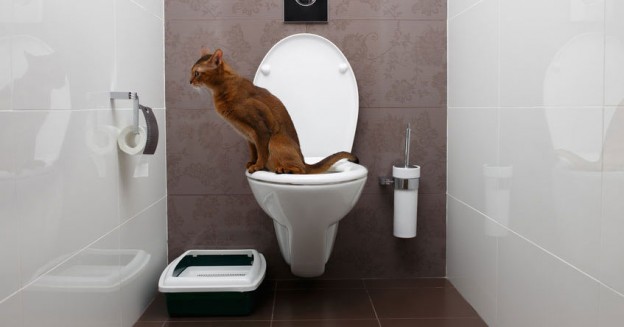The Risks of Flushing Cat Poop in Your Toilet - Precautionary Measures
The Risks of Flushing Cat Poop in Your Toilet - Precautionary Measures
Blog Article
Just how do you really feel on the subject of How to Dispose of Cat Poop and Litter Without Plastic Bags?

Introduction
As cat owners, it's important to bear in mind exactly how we take care of our feline buddies' waste. While it might seem practical to flush feline poop down the bathroom, this technique can have destructive effects for both the atmosphere and human wellness.
Environmental Impact
Purging cat poop introduces unsafe microorganisms and bloodsuckers right into the supply of water, presenting a significant risk to water ecosystems. These pollutants can adversely impact aquatic life and concession water top quality.
Health Risks
In addition to ecological concerns, flushing cat waste can also present health risks to people. Pet cat feces might include Toxoplasma gondii, a bloodsucker that can cause toxoplasmosis-- a potentially extreme illness, especially for expectant ladies and individuals with weakened immune systems.
Alternatives to Flushing
Thankfully, there are safer and more accountable methods to get rid of cat poop. Think about the complying with options:
1. Scoop and Dispose in Trash
The most common technique of taking care of cat poop is to scoop it into a biodegradable bag and toss it in the garbage. Be sure to use a devoted litter inside story and get rid of the waste quickly.
2. Usage Biodegradable Litter
Select naturally degradable cat clutter made from products such as corn or wheat. These clutters are eco-friendly and can be safely taken care of in the garbage.
3. Bury in the Yard
If you have a backyard, take into consideration burying cat waste in a designated area far from vegetable gardens and water resources. Be sure to dig deep enough to stop contamination of groundwater.
4. Set Up a Pet Waste Disposal System
Purchase a pet waste disposal system especially made for pet cat waste. These systems utilize enzymes to break down the waste, decreasing odor and ecological effect.
Conclusion
Liable family pet possession expands past supplying food and sanctuary-- it likewise includes appropriate waste administration. By refraining from purging cat poop down the commode and selecting alternative disposal techniques, we can minimize our environmental impact and protect human health and wellness.
Why Can’t I Flush Cat Poop?
It Spreads a Parasite
Cats are frequently infected with a parasite called toxoplasma gondii. The parasite causes an infection called toxoplasmosis. It is usually harmless to cats. The parasite only uses cat poop as a host for its eggs. Otherwise, the cat’s immune system usually keeps the infection at low enough levels to maintain its own health. But it does not stop the develop of eggs. These eggs are tiny and surprisingly tough. They may survive for a year before they begin to grow. But that’s the problem.
Our wastewater system is not designed to deal with toxoplasmosis eggs. Instead, most eggs will flush from your toilet into sewers and wastewater management plants. After the sewage is treated for many other harmful things in it, it is typically released into local rivers, lakes, or oceans. Here, the toxoplasmosis eggs can find new hosts, including starfish, crabs, otters, and many other wildlife. For many, this is a significant risk to their health. Toxoplasmosis can also end up infecting water sources that are important for agriculture, which means our deer, pigs, and sheep can get infected too.
Is There Risk to Humans?
There can be a risk to human life from flushing cat poop down the toilet. If you do so, the parasites from your cat’s poop can end up in shellfish, game animals, or livestock. If this meat is then served raw or undercooked, the people who eat it can get sick.
In fact, according to the CDC, 40 million people in the United States are infected with toxoplasma gondii. They get it from exposure to infected seafood, or from some kind of cat poop contamination, like drinking from a stream that is contaminated or touching anything that has come into contact with cat poop. That includes just cleaning a cat litter box.
Most people who get infected with these parasites will not develop any symptoms. However, for pregnant women or for those with compromised immune systems, the parasite can cause severe health problems.
How to Handle Cat Poop
The best way to handle cat poop is actually to clean the box more often. The eggs that the parasite sheds will not become active until one to five days after the cat poops. That means that if you clean daily, you’re much less likely to come into direct contact with infectious eggs.
That said, always dispose of cat poop in the garbage and not down the toilet. Wash your hands before and after you clean the litter box, and bring the bag of poop right outside to your garbage bins.
https://trenchlesssolutionsusa.com/why-cant-i-flush-cat-poop/

Do you appreciate reading up on Can You Flush Cat Poo or Litter Down the Toilet?? Try to leave a short review further down. We would be pleased to hear your responses about this content. In hopes to see you back again in the near future. Please set aside a second to promote this article if you enjoyed it. Thanks a lot for your time invested reading it.
Need Help? Hire Us Now! Report this page